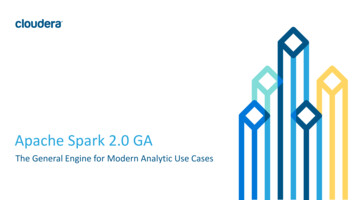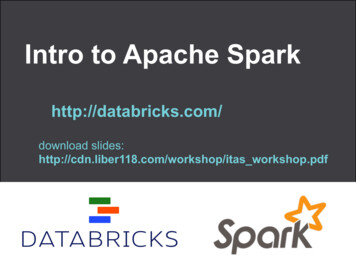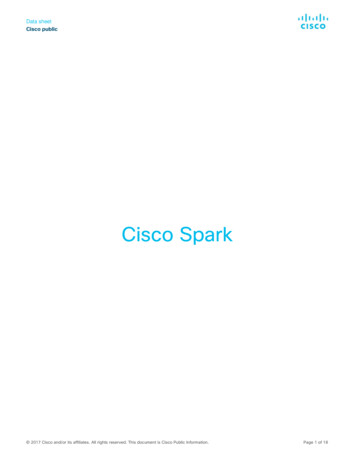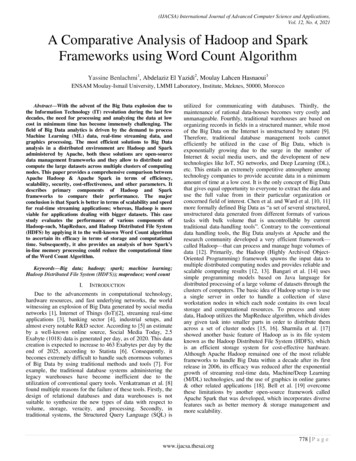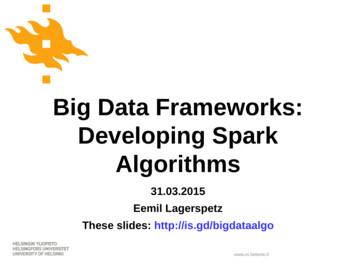
Transcription
Big Data Frameworks:Developing SparkAlgorithms31.03.2015Eemil LagerspetzThese slides: http://is.gd/bigdataalgowww.cs.helsinki.fi
Outline Part I: Intro Use Cases Spark Vision MLlib Some AlgorithmsPart II: How to Design Spark Algorithms Designing Spark algorithms Important numbers The Hard Part Idioms and Patterns Tips
Developing Spark algorithms: Why? Why not Hadoop or Insert another framework here ? Richer programming model Not just Map and Reduce (and Combine) Speed and In-Memory computationWith Hadoop/Map-Reduce, it is difficult to represent complexalgorithms
Spark Algorithms: Use Cases Analytics and Statistics, Data Mining, Machine Learning, Pattern recognition, anomaly detection (spam, malware, fraud) Identification of key or popular topics Content classification and clustering, recommender systems Large-scale, Scalable Systems More Efficient Parallel Algorithms You don't need to implement the parallelism every timeCost Optimization, Flexibility – Cloud instead of Grid
Analytics and Statistics The aim of data analytics is to find new information in data The process builds on statistics Why Spark? Processing large datasets Past and current dataThe overall process has many steps Data selection, preprocessing, transformations, data mining anddevelopment of patterns and models, interpretation and evaluation This sounds a lot like Spark: a pipeline of phasesDataFeatureExtractionModelTrainingFinal Model
Data mining techniques Classification, Clustering Collaborative filtering Dimensionality reduction Frequent pattern mining Regression, Anomaly detection Supervised learning, Feature learning, Online learning Topic models Unsupervised learning All of this can probably be done with Spark, but may requirecase-by-case algorithm redesign Why? Ability to process very large datasets
MLlib MLl (MLlib): An API for Distributed Machine Learning Evan Sparks, Ameet Talwalkar, et al. International Conference on Data Mining (2013) http://arxiv.org/abs/1310.5426
Algorithms in MLlib v1.0 Classificationlogistic regression, linear support vector machines (SVM), naïve Bayes,least squares, decision trees Regression Collaborative filtering k-meansOptimization alternating least squares (ALS), non-negative matrix factorization (NMF)Clustering linear regression, regression treesstochastic gradient descent (SGD), limited memory BFGSDimensionality reduction singular value decompositon (SVD), principal component analysis (PCA)
Spark K-Means Exampleval data sc.textFile("kmeans.txt")val parsedData data.map( .split(" ").map( .toDouble()).cache()val clusters KMeans.train(parsedData, 2,numIterations 20)val cost clusters.computeCost(parsedData)println("Sum of squared errors: " cost)Source: MLlib and Distributing the Singular Value Decomposition, Reza Zadeh, ICME and Databricks, 2014.
Without MLLib// Initialize K cluster centerscenters data.takeSample(false, K, seed)while (d epsilon) {// assign each data point to the closest clusterclosest data.map( p (closestPoint(p, centers), p))// assign each center to be the mean of its data pointspointsGroup closest.groupByKey()newCenters pointsGroup.mapValues(ps average(ps))d distance(centers, newCenters)}S. Venkataraman. Machine Learning on Spark. Strata Conference, February 2013.
Part II Developing Spark Algorithms How to convert existing local algorithms to the Spark parallelmodel
Developing Spark Algorithms Do not duplicate work Check if it exists in MLlib Is there a Spark Package for it? http://spark-packages.org/ Has someone made it for Hadoop? If no, then Find a pseudocode or the math Think it through in a parallel way The hard part
The Hard Part: Global State 1/2 Check for immutable global data structures and replace them with Broadcasts in Sparkint[] supportData {0, 1, 2, 3, 4} val supportArray Array(0, 1, 2, 3, 4)val supportData sc.broadcast(supportArray)
The Hard Part: Global State 2/2 Check for mutable global data structuresChange them to Broadcasts, and only change their content after atransformation/action is complete int[] mutableData {0, 1, 2, 3, 4} var mut sc.broadcast(Array(0, 1, 2, 3, 4))val updated:Array[(Int, Int)] dataRdd.map{x x%5 - mut.value(x%5)*x/* which index was updated, and what is the new value*/}.reduceByKey( ).collect.sortBy( . 1)mut sc.broadcast(updated.map( . 2)) And then loop again .
Dealing with sliding windowsint[] data input;int[] result new int[data.length];for (int i 1; i data.length; i ){result[i-1] data[i] * data[i-1];} The above takes pairs starting from 0, 1 In Spark we can use zip to do this
Dealing with sliding windowsval data0 12val rdd sc.textFile("input")val paired:RDD[(Int, Int)] rdd.dropRight(1).zip(rdd.drop(1))paired.map(p p. 1*p. 2).saveAsTextFile("result") If we also need ordering, we need to Have line numbers in the original file, or .)
Dealing with orderingval ord rdd.mapPartitionsWithIndex{part val (idx:Int, items:Iterable[(Int, Int)]) partitems.toArray.zipWithIndex.map{p val ((p1, p2), index) p(idx, index) - p. 1*p. 2 }}Now items are prefixed with file part and their position in that part,e.g. (0, 0), (0, 1), (0, 2), (1, 0), (1, 1), (1,2), We can sort by this and save the results to preserve orderord.sortBy( . 1).map( . 2).saveAsTextFile("results")
The Hard Part: Interdependent loops Check for state dependencies in loopsint[] data new int[n];for (int i 0; i n; i ) {for (int j 0; j i; j )data[i] i * data[j];} This depends on all the previously calculated valuesIt will be very hard to convert this kind of algorithm toSpark, perhaps find another approach Or figure it out case-by-case.
The Hard Part: Figuring it outint[] data new int[n];for (int i 0; i n; i ) {for (int j 0; j i; j )data[i] i * data[j];} The above just does i * sum(0 until i) (i is not included) We can do that in Spark easily:val rdd sc.parallelize(0 until n)val finalData rdd.map(i i * (0 until i).sum) So, even interdependent loops can be converted,if you figure them out
Hard Part over Spark Practicals next (You can wake up now)
Important Numbers 1/3 Data size: How many GB? How large files? How many files? Hadoop/Spark prefers 500MB filesHow many tasks?sc.textFile("data", tasks) Minimum: 2xCPU cores in cluster Optimal: Each computer's memory is used fully for tasks Maximum: Too large high overheadSpark does not tune this for you – It depends on your job
Important Numbers 2/3 How many objects? How large are they? How many coresper computer, how many objects does each process? --conf spark.task.cpus X to control thisExample VM: 8 cores/tasks, 32GB RAM Spark has 4GB /core. Too little?Set cpus 2 and Spark will assign 8/2 4 tasks to thenode at a time.
Important Numbers 3/3 Does your task cause the data size to grow? How much?Deserialization, data grouping, data multiplication with cartesian()or tasks size possibly doubling with join() rdd.mapPartitions(func) makes one task handle onefile/partition, this is more efficient if your objects are small With this, all the objects of one partition are available at the VM rdd.mapPartitions( part part.map( x x*2 )) Results in the same thing asrdd.map( x x*2 ) Tip: mapPartitions returns an Iterable, so you can do filtering toobefore returning it
Practicals: import SparkContext.Import org.apache.spark.SparkContextImport SparkContext. The above is needed so that RDDs have groupByKey etcadvanced operationsThis imports Spark's implicit imports,like PairedRDD functions (key-value stuff)
Practicals: Keys and Values In Spark, any RDD of type (a, b) is an RDD of keys and values Keys can be used in groupByKey, reduceByKey, etc.Example:val data Array( ((0,1), "first"),((1,0), "second"))val rdd sc.parallelize(data)// rdd: RDD[((Int , Int), String)] Here (Int, Int) is the key Key can be any class that implements hashCode, for example,any Tuple (of any length), or any case class Optionally, you can implement Ordering to allow sortByKey
Spark key-value RDD pattern Use RDDs of type k - v to allow reduceByKey, groupByKey, sortByKey, . Cleaner than rdd.groupBy( .x)Load text data directly to (k, v) RDD:case class MovieInfo(title:String, genres: Array[String])val txt sc.textFile("moviedata")val movies txt.map{ line line.split("::") match {case Array(id, title, genres, *) id.toInt - new MovieInfo(title, genres.split(" "))}}// movies: RDD[(Int, MovieInfo)]
Naming Tuple Fields in Transformationssomething.map{ x val (a, b, c, d, e) x(a, c, d) } Allows splitting a tuple to elements on the first line Naming: no need to get confused by tuple indicessomething.map{ x val (a, (b, c, d, e)) x(c, (a, e)) } Supports nested tuples like above. Can be done with case too:something.map{ case (a, (b, c, d, e)) (c, (a, e)) }
Tips: Joining two datasetsval xrdd sc.textFile(p).map(x x.head - x.tail)val yrdd sc.textFile(q).map(y y.head - y.tail) First element is always key, second the dataval grouped xrdd.groupWith(yrdd)// grouped: RDD[(Char, (Iterable[String],Iterable[String]))] This is the same asval xg xrdd.groupByKeyval yg yrdd.groupByKeyval grouped xg.join(yg)
Idioms Text data parsing: Scala pattern match Idiomcase class Movie(id:Int, title:String, genres:Array[String])val txt sc.textFile("moviedata")val movies txt.map{ line line.split("::") match {case Array(id, title, genres) new Movie(id.toInt, title, genres.split(" "))}} The use of the pattern matcher avoids array size exceptions Allows naming fields of the split Array directly at the case statement
Idioms Self-contained text formatting and print statementprintln(s"""First items are: {xrdd.take(5).mkString(", ")}And the mean is {xrdd.reduce( ) / xrdd.count}""")(String interpolation)allows complex code inside a String s" var" Multiline Strings (""") help make this readable Separate mkString and other string formatting logic from mainprogram logic (to reduce clutter) Keep printing and formatting-related code in a single place
Bring argument class fields to scope// x is acase class Movie(movieId:Int, title:String,genres:Array[String])something.map{ x import x.movieId - title}
Tips: Changing data path and master Main program structure for running on a cluster plus testing locally Give -Dspark.master local[2] in VM args in Eclipse, or command linereplace with -Dspark.master spark://ukko123.hpc.cs.helsinki.fi:7077main(args: Array[String]) {val dataPath args(0)val conf newSparkConf().setAppName(getClass.getName)val sc new SparkContext(conf)val dataRdd sc.textFile(dataPath)// }
Thanks These slides: http://is.gd/bigdataalgo Spark index.html Eemil Lagerspetz Eemil.lagerspetz@cs.helsinki.fi IRC channel: #tkt-bdf After Thu 2015-04-02, this slideset will include converting the Pearsoncorrelation algorithm to Spark Contact us for more tips :)
Converting Pearson to Spark Start with the math(Wikipedia) Required components: Two datasets with equal length (n) Mean of both datasets (mx and my) Upper: Product of difference from mean at each index i of both datasetsLower:Standard deviation (sqrt of square difference sum) of each datasetseparately, multiplied
Converting Pearson to Spark Mean is needed beforecalculating SD and the upper side, so do it separately:val xdata Array(0.0, 2.0, 4.0, 6.0, 8.0, 10.0)val xrdd sc.parallelize(xdata)val ydata Array(1.0, 3.0, 5.0, 7.0, 9.0, 9.0)// Correct result for these is r 0.982val yrdd sc.parallelize(ydata)val mx xrdd.reduce( ) / xrdd.count // 5.0val my yrdd.reduce( ) / xrdd.count // 5.67
Converting Pearson to Spark Upper part needs us to combine both datasets by index. We do this with zip:val both xrdd.zip(yrdd)val upper both.map{ pair (pair. 1 - mx)*(pair. 2 - my)}.reduce( ) // 60.0 The lower part has similar components, but the difference is squared beforesumming up:val (lowerx, lowery) both.map{ pair math.pow((pair. 1 - mx), 2) - math.pow((pair. 2 – my), 2)}.reduce((a, b) (a. 1 b. 1, a. 2 b. 2)) // 70.0, 53.33val r upper / (math.sqrt(lowerx) * math.sqrt(lowery))// 0.9819805060619657 Correct result.
Optimizing Pearson We ran three map-reduces (mean, upper, lower). What if we could do it in two?(mean, upper lower)val (upper, lowerx, lowery) both.map{ pair val up (pair. 1 - mx)*(pair. 2 - my)val lowx math.pow((pair. 1 - mx), 2)val lowy math.pow((pair. 2 - my), 2)(up, lowx, lowy)}.reduce{(a, b) (a. 1 b. 1, a. 2 b. 2, a. 3 b. 3)}// 60.0, 70.0, 53.33val r upper / (math.sqrt(lowerx) * math.sqrt(lowery))// 0.9819805060619657
Whole thing on one slideval xrdd sc.parallelize(Array(0.0, 2.0, 4.0, 6.0, 8.0, 10.0))val yrdd sc.parallelize(Array(1.0, 3.0, 5.0, 7.0, 9.0, 9.0))val mx xrdd.reduce( ) / xrdd.count // 5.0val my yrdd.reduce( ) / xrdd.count // 5.67val (upper, lowerx, lowery) xrdd.zip(yrdd).map{ pair val up (pair. 1 - mx)*(pair. 2 - my)val lowx math.pow((pair. 1 - mx), 2)val lowy math.pow((pair. 2 - my), 2)(up, lowx, lowy)}.reduce{(a, b) a. 3 b. 3)}(a. 1 b. 1, a. 2 b. 2,// 60.0, 70.0, 53.33val r upper / (math.sqrt(lowerx) * math.sqrt(lowery))// 0.9819805060619657
Spark Algorithms: Use Cases Analytics and Statistics, Data Mining, Machine Learning, Pattern recognition, anomaly detection (spam, malware, fraud) Identification of key or popular topics Content classification and clustering, recommender systems Large-scale, Scalable Systems More Efficient Parallel Algor
